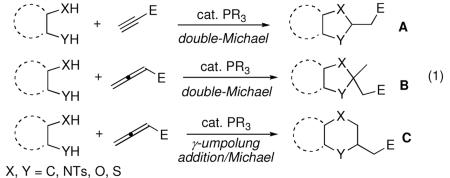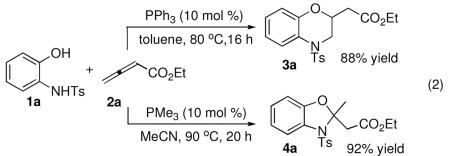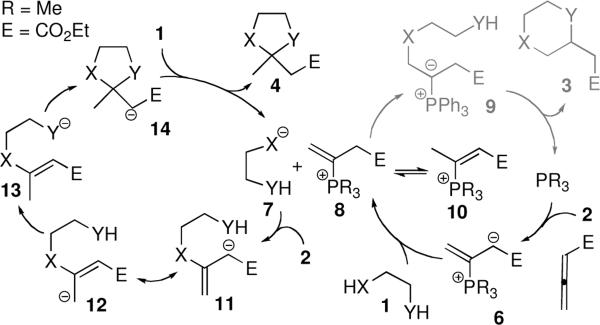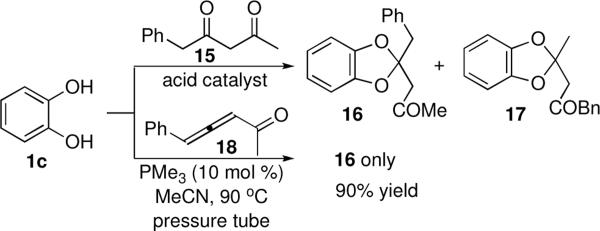Abstract
General base-catalyzed double-Michael reactions of allenes with various dinucleophiles are described. The reactions are facilitated most efficiently by a catalytic amount of trimethylphosphine, affording six types of C2-functionalized benzannulated five-membered heterocycles: benzimidazolines, benzoxazolines, benzothiazolines, 1,3-benzodioxoles, 1,3-benzoxathioles, and 1,3-benzodithioles. This atom-economical reaction is operationally simple and provides the product heterocycles in good to excellent yields. Careful mechanistic studies unveiled the phosphine-triggered general base catalysis pathway. Furthermore, the double-Michael reaction can serve as an alternative method for the selective mono-ketalization of β-diketones.
C2-Functionalized benzannulated 1,3-diheteroatom five-membered rings are useful compounds for medicinal purposes and in materials chemistry.1 For instance, some 1,3-benzodioxoles display endothelin antagonist, antiinflammatory, antimicrobial, and antitumor activities.2 1,3-Benzothiazolines are used as antioxidants to improve the oxidative stability of rubbers, polymers, and plastics.3 These scaffolds are commonly synthesized through dehydrative condensation of 1,2-disubstituted benzenes with aldehydes or ketones in the presence of acid catalysts.4 The reaction conditions are, however, often harsh, employing strong dehydrating agents (e.g., P2O5) or superstoichiometric amounts of acid, requiring tedious work-up.5 In addition, no single set of conditions reported previously can be applied to the preparation of all six benzannulated 1,3-diheteroatom five-membered rings.
The Michael reaction is one of the most versatile processes in organic synthesis.6 While intramolecular Michael reactions of compounds featuring donor/acceptor groups are valuable for forming functionalized cyclic compounds from acyclic starting materials,7 intermolecular double-Michael reactions are particularly powerful tools for assembling complex cyclic products from simple acyclic starting materials. Among the intermolecular double-Michael reactions, the union of two olefins, functioning as both acceptor and donor, is most common.8 Recently, we disclosed the phosphine-catalyzed double-Michael reactions of dinucleophiles with acetylenes as a powerful method for synthesizing heterocycles A (Eq 1).9 Although, theoretically, disubstituted acetylenes could be used to introduce a quaternary center (as in B), we found that any additional substituent at the β-carbon atom of the activated acetylene prohibited its double-Michael reaction. Double-Michael reactions of dinucleophiles with allenes, which have the same degree of unsaturation as acetylenes yet enhanced reactivity, would conceivably also yield heterocycles B;10 it has been reported, however, that allenes typically undergo tandem γ-umpolung addition/Michael cyclization, forming heterocycles C, in the presence of phosphines.11 Herein, we report a new phosphine-triggered general base-catalyzed tandem double-Michael reaction of dinucleophiles with allenes, affording, under simple and mild conditions, highly functionalized heterocycles B featuring fully substituted carbon centers.
 |
The tandem umpolung addition/Michael cyclization of dinucleophiles and allenoates is typically facilitated by PPh3.11 Indeed, treatment of N-tosyl-2-aminophenol (1a)12 and the allene 2a with PPh3 (10 mol %) provided the benzomorpholine 3a in 88% yield (Eq 2). Switching the catalyst to PMe3, however, led to production of the double-Michael product 4a in 92% yield.13 The addition of PMe3 to allenoate 2a is speculated to form a phosphonium enolate that acts as a general base and promote the formation of the double-Michael product 4a (see mechanistic studies below). To test this hypothesis, we also examined the double-Michael reactions mediated by amines and inorganic bases.
 |
N-Tosyl-2-aminophenol (1a) was reacted with allene 2b in the presence of an amine (0.1 equiv) or an inorganic base (1.1 equiv) in MeCN at 90 °C (Table 1). While PMe3 provided the double-Michael adduct 4b in 86% yield (entry 1), amine bases displayed varying degrees of success. Among the common nucleophilic amine bases, DMAP performed better than quinuclidine, 3-hydroxyquinuclidine (3-HQD), and DABCO, exhibiting efficiency comparable with that of PMe3 (entries 2–5). Neither the basicity14 nor the nucleophilicity15 of the amine base followed the same trend as the reaction efficiency, hinting at a complex multistep reaction mechanism (vide infra). The inorganic bases also facilitated the reaction, albeit with much diminished efficiency (entries 6–8). Focusing on the double-Michael reaction with PMe3 and DMAP, we investigated a variety of nucleophiles and allenes for the construction of benzannulated 1,3-diheteroatom five-membered cycles.
Table 1.
Double-Michael Reactions of the Amidophenol 1a and the Allene 2b Mediated by Different Basesa
| entry | baseb | pKa(H2O)c | nucleophilicity d | yield(%)e |
|---|---|---|---|---|
| 1 | PMe3 | 8.7 | 15.49f | 86 |
| 2 | quinuclidin e | 11.3 | 20.54g | 26 |
| 3 | 3-HQD | 9.9 | 54 | |
| 4 | DABCO | 8.7 | 18.80g | 77 |
| 5 | DMAP | 9.2 | 15.80h (14.95)g | 82 |
| 6 | Na2CO3 | 10.3 | 35 | |
| 7 | NaHCO3 | 6.3 | 16 | |
| 8 | NaOAc | 4.8 | 53 |
Reactions were performed using 0.4 mmol of 1a and 1.1 equiv of 2b.
For the complete list of bases tested, see the Supporting Information.
Isolated yield.
The value is the nucleophilicity of PBu3 (in CH2Cl2).
Nucleophilicity in MeCN.
Nucleophilicity in CH2Cl2.
The PMe3-mediated double-Michael reaction was generally applicable to a variety of ortho-substituted phenol, aniline, and thiophenol dinucleophiles (Table 2). Under the simple conditions of heating the dinucleophile at 90 °C in MeCN in the presence of the allenoate 2a and PMe3 (10 mol %), 2-mercaptophenol provided the 1,3-benzoxathiole 4c in 93% yield (entry 1).16 The 1,3-benzodioxole 4d and the 1,3-benzodithiole 4e were also formed readily in good yields (entries 2 and 3). In contrast, N-tosyl-2-aminothiophenol17 and N,N'-ditosyl-1,2-diaminobenzene18 produced only their mono-Michael adducts at 90 °C; a temperature of 120 °C was required to facilitate full conversions to their double-Michael products, the benzothiazoline 4f and the benzimidazoline 4g, respectively (entries 4 and 5). The presence of a chlorine substituent did not affect the double-Michael reaction of 1g, giving the benzoxazoline 4h in 84% yield (entry 6). When DMAP (10 mol %) was used, only moderate amounts of the benzothiazoline 4f and the benzimidazoline 4g were obtained (entries 4 and 5).
Table 2.
Double-Michael Annulations of Various Dinucleophilesa
| entry | X,Y | Z | product | yield (%)b | |
|---|---|---|---|---|---|
| PMe3 | DMAP | ||||
| 1 | O, S (1b) | H | 4c | 93 | |
| 2 | O, O (1c) | H | 4d | 80 | |
| 3 | S, S (1d) | H | 4e | 74 | |
| 4c | S,NTs (1e) | H | 4f | 68 | 53 |
| 5c | NTs, NTs (1f) | H | 4g | 79 | 38 |
| 6 | O, NTs (1g) | CI | 4h | 84 | |
Reactions were performed using 0.4 mmol of 1 and 1.1 equiv of 2a.
Isolated yield after chromatography.
Reaction performed initially at 90 °C to obtain the mono-Michael adduct; the temperature was then raised to 120 °C for full conversation to the double-Michael product.
To form fully substituted C2 centers decorated with groups other than Me and CH2CO2Et units, we surveyed the reactions of various α- and γ-substituted allenoates (Table 3). Allenoates with γ-substituents19 of varying steric and electronic demand were well suited to double-Michael reactions with N-tosyl-2-aminophenol, 2-mercaptophenol, and catechol (entries 1–11). Furthermore, the reactions of α-substituted allenoates20 with catechol provided the 1,3-benzodioxoles 4t–v in excellent yields (entries 12–14). With N-tosyl-2-aminophenol as the dinucleophile, α-substituted allenoates generated mixtures of diastereoisomers with poor selectivity, albeit in excellent yields (entries 15–17). In general, DMAP was a less-efficient catalyst than PMe3, with some exceptions (entries 2, 4, and 6). We observed a particularly noteworthy improvement in the product yield when DMAP was used for the reaction of the γ-benzyl allenoate 2d (entries 2 and 6). The lower yield with PMe3 was likely due to isomerization of the γ-benzyl allenoate 2d to the corresponding diene.21 The generally superior performance of PMe3 over DMAP might be due to the phosphonium cation being better than the pyridinium ion at forming a spectator countercation for the general bases.
Table 3.
Double-Michael Annulations of Substituted Allenoatesa
| entry | X, Y | R1,R2 | product | yield (%)b | |
|---|---|---|---|---|---|
| PMe3 | DMAP | ||||
| 1 | O,NTs | Ph, H (2c) | 4i | 83 | |
| 2 | O,NTs | Bn, H (2d) | 4j | 61 | 77 |
| 3 | O,NTs | t-Bu, H (2e) | 4k | 69 | 51 |
| 4 | O,S | Me,H | 4l | 74 | 76 |
| 5 | O,S | Ph,H | 4m | 86 | |
| 6 | O,S | Bn,H | 4n | 65 | 89 |
| 7 | O,S | t-Bu, H | 4o | 58 | 48 |
| 8 | O,O | Me,H | 4p | 70 | 68 |
| 9 | O,O | Ph,H | 4q | 77 | |
| 10 | O,O | Bn,H | 4r | 89 | 74 |
| 11 | O,O | t-Bu, H | 4s | 82 | 68 |
| 12 | O,O | H, Me (2f) | 4t | 89 | |
| 13 | O,O | H, Bn (2g) | 4u | 86 | |
| 14 | O,O | H, CH2CO2Et(2h) | 4v | 80 | |
| 15c | O,NTs | H,Me | 4w | 81d | |
| 16c | O,NTs | H,Bn | 4x | 73d | |
| 17c | O,NTs | H, CH2CO2Et | 4y | 84d | |
Reactions were performed using 0.4 mmol of 1 and 1.35 equiv of 2.
Isolated yield.
NaOAc (50 mol %) was added.
Diastereoisomeric ratio determined using 1H NMR spectroscopy. Diastereomeric ratios 1:1, 2:1, and 1.2:1 for 4w, 4x, and 4y, respectively.
We gleaned clues regarding the mechanism of this new phosphine-mediated double-Michael reaction from the isolation of the mono-Michael product 5a13 of N-tosyl-2-aminophenol (1a) and the allenoate 2b (Eq 3). Intriguingly, when we heated 5a in MeCN in the presence of catalytic PMe3, we obtained almost no cyclized product 4b. On the other hand, exposure of 5a to catalytic PMe3 and the allenoate 2b in MeCN at 90 °C provided the double-Michael product 4b in 80% yield. Most interestingly, treatment of 5a with catalytic PMe3 and 1.1 equivalent of the allenoate 2a also rendered formation of the benzoxazoline 4b. Notably, we detected no product 4a, arising from the elimination of 1a from 5a and subsequent double-Michael reaction of the allenoate 2a.
 |
Based on these insights, we propose the following mechanism for the double-Michael reaction (Scheme 1). Nucleophilic addition of the phosphine to the allenoate 2 results in the phosphonium enolate 6. Protonation of 6 by the pronucleophile 1 leads to the formation of a nucleophile/phosphonium salt pair 7·8, which undergoes γ-umpolung addition to yield the ylide 9 when PPh3 is employed as the catalyst.11 In contrast, the more-electron-rich phosphine PMe3 does not facilitate umpolung addition.22 As we had observed for the double-Michael reactions of acetylenes, the β,β-disubstituted enoate 10 did not undergo the Michael reaction.9 Instead, the nucleophile 7 adds to the allenoate 2. The resulting dienolate 11 undergoes γ-protonation to form the α,β-unsaturated enoate 13, which is primed for a second Michael addition. The cyclic enolate 14 can further facilitate the double-Michael reaction cycle by deprotonating the pronucleophile 1 (or mono-Michael product; e.g., 5a in Scheme 1) to produce the product 4, supporting the notion of general base catalysis.23 The observation of no cyclized product derived from the allenoate 2a in Eq 3 also suggests that the second Michael addition is facile and that the intermediate 11 does not revert back to the allenoate 2 and the nucleophile 7.
scheme1.
Scheme 1.Mechanism of the Double-Michael Reactions of Allenes
Scheme 2 demonstrates an additional application of this double-Michael reaction: what amounts to the selective ketalization of asymmetric β-diketones. The ketalization of the β-diketone 15 with catechol would produce a mixture of the acetals 16 and 17. Conversely, the double-Michael reaction of catechol with the allenone 1824 produced only the acetal 16 in 90% yield.
scheme2.
Scheme 2.Selective Synthesis of a β-Diketone Mono-acetal
In summary, we have developed a phosphine-triggered general base-catalyzed double-Michael reaction that enables the syntheses of six different C2-functionalized benzannulated 1,3-diheteroatom five-membered rings from dinucleophiles and allenes. The reported processes are operationally simple, atom-economical, minimize the generation of chemical waste, and employ mild reaction conditions. Based on the results of experiments performed using an isolated mono-Michael adduct, we have established a general base catalysis mechanism for what appears to be a phosphine catalysis reaction. Such mechanistic insight introduces a new twist to the growing number of phosphine-catalyzed annulation reactions25 and suggests what might be a general role of phosphines in other annulation processes. This highly efficient methodology also circumvents the synthetic problem of non-selective ketalization of β-diketones. Our focus is now on expanding the scope of the pronucleophile, examining the diastereoselectivity of the double-Michael reaction when using α-substituted allenes, and exploring the umpolung addition/Michael reaction using 1,2-disubstituted benzenes.
Supplementary Material
Acknowledgment
This research was supported by the NIH (R01GM071779, P41GM081282). O.K. thanks Profs. Daniel A. Singleton (Texas A&M University) and Louis S. Hegedus (Colorado State University) for helpful discussions.
Footnotes
Supporting Information Available: Representative experimental procedures, characterization data and copies of 1H and 13C NMR spectra for all new compounds (PDF). Crystallographic data for 3b, 4b, and 5c (CIF). This information is available free of charge via the Internet at http://pubs.acs.org.
References
- 1.Boshta NM, Bomkamp M, Waldvogel SR. Tetrahedron. 2009;65:3773. [Google Scholar]
- 2.a Jae H-S, Winn M, von Geldern TW, Sorensen BK, Chiou WJ, Nguyen B, Marsh KC, Opgenorth TJ. J. Med. Chem. 2001;44:3978. doi: 10.1021/jm010237l. [DOI] [PubMed] [Google Scholar]; b Ullrich T, Baumann K, Welzenbach K, Schmutz S, Camenisch G, Meingassner JG, Weitz-Schmidt G. Bioorg. Med. Chem. Lett. 2004;14:2483. doi: 10.1016/j.bmcl.2004.03.006. [DOI] [PubMed] [Google Scholar]; c Leite ACL, da Silva KP, de Souza IA, de Araújo JM, Brondani DJ. Eur. J. Med. Chem. 2004;39:1059. doi: 10.1016/j.ejmech.2004.09.007. [DOI] [PubMed] [Google Scholar]
- 3.Robert DP, Frank AH. US Patent 4708810. 1987
- 4.Prakash GKS, Mathew T, Panja C, Vaghoo H, Venkataraman K, Olah GA. Org. Lett. 2007;9:179. doi: 10.1021/ol062562e. [DOI] [PubMed] [Google Scholar]
- 5.a Iwagami H, Yatagai M, Nakazawa M, Orita H, Honda Y, Ohnuki T, Yukawa T. Bull. Chem. Soc. Jpn. 1991;64:175. [Google Scholar]; b Chan TH, Brook MA, Chaly T. Synthesis. 1983:203. [Google Scholar]
- 6.a Michael A. J. Prakt. Chem. 1887;35:349. [Google Scholar]; b Jung ME. In: Comprehensive Organic Synthesis. Trost BM, Fleming I, Semmelhack MF, editors. Vol. 4. Pergamon; Oxford: 1991. pp. 1–68. Chapter 1.1. [Google Scholar]; c Perlmutter P. Conjugate Addition Reactions in Organic Synthesis. Elsevier Science; New York: 1992. [Google Scholar]
- 7.a Ihara M, Fukumoto K. Angew. Chem., Int. Ed. Engl. 1993;32:1010. [Google Scholar]; b Parsons PJ, Stefinovic M. Synlett. 1993:931. [Google Scholar]
- 8.a Enders D, Hüttl MRM, Grondal C, Raabe G. Nature. 2006;441:861. doi: 10.1038/nature04820. [DOI] [PubMed] [Google Scholar]; b Lu Z, Chai G, Ma S. Angew. Chem., Int. Ed. Engl. 2008;47:6045. doi: 10.1002/anie.200801497. [DOI] [PubMed] [Google Scholar]; c Zhang X, Zhang S, Wang W. Angew. Chem., Int. Ed. Engl. 2010;49:1481. doi: 10.1002/anie.200906050. [DOI] [PubMed] [Google Scholar]
- 9.a Sriramurthy V, Barcan GA, Kwon O. J. Am. Chem. Soc. 2007;129:12928. doi: 10.1021/ja073754n. [DOI] [PMC free article] [PubMed] [Google Scholar]; b Sriramurthy V, Kwon O. Org. Lett. 2010;12:1084. doi: 10.1021/ol100078w. [DOI] [PMC free article] [PubMed] [Google Scholar]
- 10.Cabiddu S, Cadoni E, Ciuffarin E, Fattuoni C, Floris C. J. Heterocycl. Chem. 1991;28:1573. [Google Scholar]
- 11.a Cristau HJ, Fonte M, Torreilles E. Synthesis. 1989:301. [Google Scholar]; b Liu B, Davis R, Joshi B, Reynolds DW. J. Org. Chem. 2002;67:4595. doi: 10.1021/jo016154u. [DOI] [PubMed] [Google Scholar]; c Lu C, Lu X. Org. Lett. 2002;4:4677. doi: 10.1021/ol0270733. [DOI] [PubMed] [Google Scholar]; d Lu Z, Zheng S, Zhang X, Lu X. Org. Lett. 2008;10:3267. doi: 10.1021/ol8011452. [DOI] [PubMed] [Google Scholar]
- 12.Andersen KK, Gowda G, Jewell L, McGraw P, Phillips BT. J. Org. Chem. 1982;47:1884. [Google Scholar]
- 13.The structures of 3b (5-chlorobenzene variant of 3a), 4b, and 5c (5-chlorobenzene variant of 5a) were established unequivocally through X-ray crystallographic analyses. See the Supporting Information for details
- 14.a Streuli CA. Anal. Chem. 1960;32:985. [Google Scholar]; b Ripin DH, Evans DA. [(accessed June 2011)];Evans pKa Table. http://www2.lsdiv.harvard.edu/labs/evans/index.html.
- 15.a Ofial A, Mayr H. [(accessed June 2011)];Reactivity Scales. http://www.cup.unimuenchen.de/oc/mayr/CDpublika.html.; b Brotzel F, Kempf B, Singer T, Zipse H, Mayr H. Chem. Eur. J. 2007;13:336. doi: 10.1002/chem.200600941. [DOI] [PubMed] [Google Scholar]
- 16.Despite their acetal-like functionality, the heterocycles formed in this study were stable to flash column chromatography over silica gel
- 17.Mizukami S, Kono M. Chem. Pharm. Bull. 1965;13:33. doi: 10.1248/cpb.13.33. [DOI] [PubMed] [Google Scholar]
- 18.Kato T, Masu H, Takayanagi H, Kaji E, Katagiri K, Tominaga M, Azumaya I. Tetrahedron. 2006;62:8458. [Google Scholar]
- 19.Lang RW, Hansen H-J. Org. Synth. 1984;62:202. [Google Scholar]
- 20.a Kumar K, Kapur A, Ishar MPS. Org. Lett. 2000;2:787. doi: 10.1021/ol000007l. [DOI] [PubMed] [Google Scholar]; b Zhu X-F, Lan J, Kwon O. J. Am. Chem. Soc. 2003;125:4716. doi: 10.1021/ja0344009. [DOI] [PubMed] [Google Scholar]; c Tran YS, Kwon O. Org. Lett. 2005;7:4289. doi: 10.1021/ol051799s. [DOI] [PubMed] [Google Scholar]; d Zhao G-L, Shi M. Org. Biomol. Chem. 2005;3:3686. doi: 10.1039/b510572b. [DOI] [PubMed] [Google Scholar]; e Castellano S, Fiji HDG, Kinderman SS, Watanabe M, de Leon P, Tamanoi F, Kwon O. J. Am. Chem. Soc. 2007;129:5843. doi: 10.1021/ja070274n. [DOI] [PMC free article] [PubMed] [Google Scholar]; f Tran YS, Kwon O. J. Am. Chem. Soc. 2007;129:12632. doi: 10.1021/ja0752181. [DOI] [PMC free article] [PubMed] [Google Scholar]; g Lu K, Kwon O. Org. Synth. 2009;86:212. doi: 10.1002/0471264229.os086.21. [DOI] [PMC free article] [PubMed] [Google Scholar]; h Guo H, Xu Q, Kwon O. J. Am. Chem. Soc. 2009;131:6318. doi: 10.1021/ja8097349. [DOI] [PMC free article] [PubMed] [Google Scholar]; i Wang T, Ye S. Org. Lett. 2010;12:4168. doi: 10.1021/ol101762z. [DOI] [PubMed] [Google Scholar]; j Zhang Q, Yang L, Tong X. J. Am. Chem. Soc. 2010;132:2550. doi: 10.1021/ja100432m. [DOI] [PubMed] [Google Scholar]; k Wang Z, Castellano S, Kinderman SS, Argueta CE, Beshir AB, Fenteany G, Kwon O. Chem. Eur. J. 2011;17:649. doi: 10.1002/chem.201002195. [DOI] [PMC free article] [PubMed] [Google Scholar]; l Guan X-Y, Wei Y, Shi M. Eur. J. Org. Chem. 2011:2673. [Google Scholar]; m Cruz D, Wang Z, Kibbie J, Modlin R, Kwon O. Proc. Natl. Acad. Sci. U.S.A. 2011;108:6769. doi: 10.1073/pnas.1015254108. [DOI] [PMC free article] [PubMed] [Google Scholar]; n Baskar B, Dakas P-Y, Kumar K. Org. Lett. 2011;13:1988. doi: 10.1021/ol200389p. [DOI] [PubMed] [Google Scholar]; o Martin TJ, Vakhshori VG, Tran YS, Kwon O. Org. Lett. 2011;13:2586. doi: 10.1021/ol200697m. [DOI] [PMC free article] [PubMed] [Google Scholar]
- 21.Xu S, Zhou L, Zeng S, Ma R, Wang Z, He Z. Org. Lett. 2009;11:3498. doi: 10.1021/ol901334c. [DOI] [PubMed] [Google Scholar]
- 22.Tricyclohexylphosphine, which is comparable in size to triphenylphosphine, produced only the double-Michael product 4a (in yields of 93%) when mixed with the allene 1a and the nucleophile 2a
- 23.a White DA, Baizer MM. Tetrahedron Lett. 1973;14:3597. [Google Scholar]; b Yoshida T, Saito S. Chem. Lett. 1982:1587. [Google Scholar]; c Gómez-Bengoa E, Cuerva JM, Mateo C, Echavarren AM. J. Am. Chem. Soc. 1996;118:8553. [Google Scholar]; d Lumbierres M, Marchi C, Moreno-Mañas M, Sebastián RM, Vallribera A, Lago E, Molins E. Eur. J. Org. Chem. 2001:2321. [Google Scholar]; e Stewart IC, Bergman RG, Toste FD. J. Am. Chem. Soc. 2003;125:8696. doi: 10.1021/ja035232n. [DOI] [PubMed] [Google Scholar]
- 24.Kumar K, Kaur S, Ishar MPS. Synlett. 1999:1237. [Google Scholar]
- 25.a Lu X, Zhang C, Xu Z. Acc. Chem. Res. 2001;34:535. doi: 10.1021/ar000253x. [DOI] [PubMed] [Google Scholar]; b Valentine DH, Hillhouse JH. Synthesis. 2003:317. [Google Scholar]; c Methot JL, Roush WR. Adv. Synth. Catal. 2004;346:1035. [Google Scholar]; d Lu X, Du Y, Lu C. Pure Appl. Chem. 2005;77:1985. [Google Scholar]; e Nair V, Menon RS, Sreekanth AR, Abhilash N, Biju AT. Acc. Chem. Res. 2006;39:520. doi: 10.1021/ar0502026. [DOI] [PubMed] [Google Scholar]; f Ye L-W, Zhou J, Tang Y. Chem. Soc. Rev. 2008;37:1140. doi: 10.1039/b717758e. [DOI] [PubMed] [Google Scholar]; g Denmark SE, Beutner GL. Angew. Chem., Int. Ed. Engl. 2008;47:1560. doi: 10.1002/anie.200604943. [DOI] [PubMed] [Google Scholar]; h Kwong CK-W, Fu MY, Lam CS-L, Toy PH. Synthesis. 2008:2307. [Google Scholar]; i Aroyan CE, Dermenci A, Miller SJ. Tetrahedron. 2009;65:4069. [Google Scholar]; j Cowen BJ, Miller SJ. Chem. Soc. Rev. 2009;38:3102. doi: 10.1039/b816700c. [DOI] [PubMed] [Google Scholar]; k Marinetti A, Voituriez A. Synlett. 2010:174. [Google Scholar]; l Kolesinska B. Cent. Eur. J. Chem. 2010:1147. [Google Scholar]
Associated Data
This section collects any data citations, data availability statements, or supplementary materials included in this article.





